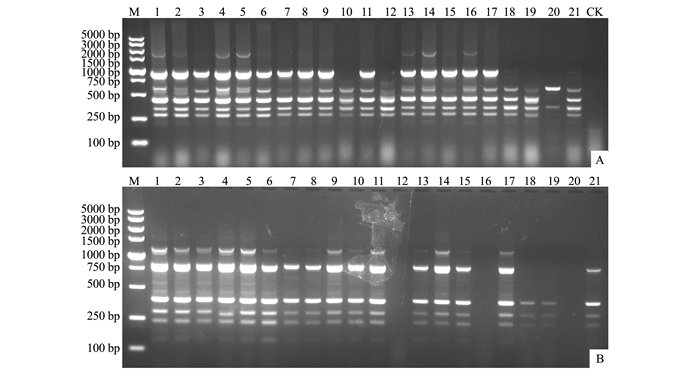ISSR-PCR Optimization and Primer Selection for Analyzing Exserohilum turcicum Isolates Collected in Fujian
-
摘要:
目的 明确适用于福建省玉米大斑病菌ISSR分子标记的反应体系和引物。 方法 采用单因素水平优化法对ISSR-PCR扩增反应中的Taq聚合酶用量、dNTPs浓度、Mg2+浓度、模板DNA浓度、PCR反应循环数以及引物的最佳退火温度等重要参数进行优化。 结果 适合福建省玉米大斑病菌群体遗传多样性分析的ISSR-PCR反应体系(25 μL)为:Taq聚合酶0.55 U、dNTPs 0.30 mmol·L-1、Mg2+ 1.30 mmol·L-1、DNA模板100 ng、引物10 pmol。ISSR-PCR扩增程序为:94℃预变性4 min;94℃变性45 s,51.2~56.0℃退火45 s,72℃延伸1.5 min,35个循环;72℃延伸10 min。利用优化的反应体系从56条ISSR引物中筛选出稳定性好、多态性高的引物10条:UBC117、UBC118、UBC808、UBC835、UBC847、UBC855、UBC856、UBC857、UBC866和UBC887,其最佳退火温度分别为55.6、53.1、51.2、51.2、56.0、53.1、53.1、51.2、51.2和51.2℃。利用优化的ISSR-PCR反应体系对21株供试菌株进行PCR扩增,结果表明,相同地理来源以及不同地理来源菌株间的DNA多态性均不同,表明福建省玉米大斑病菌群体存在丰富的遗传多样性。 结论 本研究优化的ISSR-PCR反应体系和筛选的引物可用于福建省玉米大斑病菌群体遗传多样性和遗传结构的研究。 -
关键词:
- 玉米大斑病菌 /
- 反应体系 /
- 简单序列重复区间扩增多态性 /
- 玉米大斑病 /
- 遗传多样性
Abstract:Objective To determine the optimal reaction conditions and primers for the inter-simple sequence repeat (ISSR) PCR in analyzing isolates of Exserohilum turcicum, a pathogen of the northern corn leaf blight in Fujian. Method Conditions for the ISSR-PCR amplification including Taq polymerase dosage, concentrations of dNTPs, Mg2+ and template DNA and reaction cycle as well as annealing temperatures for selected primers were optimized using a single-factor method. Result For a 25 μL ISSR-PCR genetic diversity analysis on E. turcicum, the following conditions were applied:0.55 U of Taq polymerase, 0.30 mmoL·L-1 of dNTPs, 1.30 mmoL·L-1 of Mg2+, 100 ng of template DNA, and 10 pmol of primer under 94℃ for 4 min followed by 35 cycles of 45 s at 94℃, 45 s at 51.2-56.0℃, and 1.5 min at 72℃, and finally, at 72℃ for 10 min. Ten stable, polymorphic primers, i.e., UBC117, UBC118, UBC808, UBC835, UBC847, UBC855, UBC856, UBC857, UBC866, and UBC887, were selected from 56 ISSR primers, with their optimized annealing temperatures determined to be 55.6, 53.1, 51.2, 51.2, 56.0, 53.1, 53.1, 51.2, 51.2, and 51.2℃, respectively. Regardless of their geographical origins, the 21 E. turcicum isolates differed on DNA polymorphism indicating an abundance on genetic diversity among them. Conclusion The optimized ISSR-PCR reaction conditions and primers could be applied for genetic studies on E. turcicum in Fujian. -
图 1 引物UBC847的反应体系优化
注:M:5-kb DNA Marker;(A) 1~8:Taq酶用量分别为0.25、0.35、0.45、0.55、0.65(推荐剂量)、0.75、0.85和0.95 U;(B) 1~8:dNTPs浓度分别为0.07、0.10、0.14、0.17、0.20(推荐剂量)、0.23、0.26和0.30 mmol·L-1;(C) 1~8:Mg2+浓度分别为0.5、0.8、1.0、1.3、1.5(推荐剂量)、1.7、2.0和2.2 mmol·L-1;(D) 50~200:DNA模板量分别为50、100、150和200 ng;(E) 25~40:循环数分别为25、30、35和40次;CK:空白对照。
Figure 1. Reaction condition optimization for primer UBC847
Note:M:5-kb DNA Marker; (A) 1-8:the amount of Taq polymerase 0.25, 0.35, 0.45, 0.55, 0.65 (recommended dosages), 0.75, 0.85 and 0.95 U, respectively; (B) 1-8:the concentration of dNTPs 0.07, 0.10, 0.14, 0.17, 0.20 (recommended dosages), 0.23, 0.26 and 0.30 mmol·L-1, respectively; (C) 1-8:the concentration of Mg2+ 0.5, 0.8, 1.0, 1.3, 1.5 (recommended dosages), 1.7, 2.0 and 2.2 mmol·L-1, respectively; (D) 50-200:the concentration of template DNA 50, 100, 150 and 200 ng, respectively; (E) 25-40:the cycle number 25, 30, 35 and 40, respectively; CK:blank control.
图 2 引物UBC847的最佳退火温度筛选
注:M:5-kb DNA Marker;1~8:退火温度梯度依次为56.0、55.6、54.7、53.1、51.2、49.6、48.5和48.0℃;CK:空白对照。
Figure 2. Selection of annealing temperature for primer UBC847
Note:M:5-kb DNA Marker; 1-8:the annealing temperature 56.0, 55.6, 54.7, 53.1, 51.2, 49.6, 48.5 and 48.0℃, respectively; CK:blank control.
图 3 使用引物UBC847和UBC887对福建省21个玉米大斑病菌株进行ISSR-PCR扩增
注:M:5-kb DNA Marker;1~21:福建省玉米大斑病菌的菌株序号与表 1对应;(A)和(B):引物UBC847和UBC887分别对21株玉米大斑病菌的ISSR-PCR扩增结果;CK:空白对照。
Figure 3. ISSR-PCR amplification of 21 E. turcicum isolates using primer UBC847 and UBC887
Note:M:5-kb DNA Marker; 1-21:isolates of E. turcicum in Fujian Province corresponding with Table 1; (A) and (B):ISSR-PCR amplification results of 21 E. turcicum isolates in Fujian Province using primer UBC847 and UBC887, respectively; CK:blank control.
表 1 供试的福建省玉米大斑病菌菌株
Table 1. E. turcicum isolates collected in Fujian
序号
Number菌株编号
Isolate code采集地
Location年份
Year1 JO1801 建瓯市东游镇Dongyou town of Jian′ou city 2018 2 JO1809 建瓯市东游镇Dongyou town of Jian′ou city 2018 3 JODB1701 建瓯市东游镇Dongyou town of Jian′ou city 2017 4 JODB1702 建瓯市东游镇Dongyou town of Jian′ou city 2017 5 DFDB1901 建瓯市东峰镇Dongfeng town of Jian′ou city 2019 6 DFDB1902 建瓯市东峰镇Dongfeng town of Jian′ou city 2019 7 DFDB1903 建瓯市东峰镇Dongfeng town of Jian′ou city 2019 8 DFDB1905 建瓯市东峰镇Dongfeng town of Jian′ou city 2019 9 SX1801 松溪县Songxi county 2018 10 SX1802 松溪县Songxi county 2018 11 SX1804 松溪县Songxi county 2018 12 PNDB1602a 屏南县Pingnan county 2016 13 PNDB1604b 屏南县Pingnan county 2016 14 PNDB1606a 屏南县Pingnan county 2016 15 PNDB1608a 屏南县Pingnan county 2016 16 PNDB1609a 屏南县Pingnan county 2016 17 NJDB1805 南靖县Nanjing county 2018 18 NJDB1809 南靖县Nanjing county 2018 19 NJDB1810 南靖县Nanjing county 2018 20 NJDB1816 南靖县Nanjing county 2018 21 NJDB1830 南靖县Nanjing county 2018 表 2 适宜福建省玉米大斑病菌ISSR分子标记的引物及最佳退火温度
Table 2. Primers and annealing temperatures for ISSR molecular marker of E. turcicum isolates
引物名称
Primer name引物序列(5′-3′)
Primer sequence最适退火温度(℃)
Optimal Tm引物来源
Primer origin是否适合福建种群
Whether suitable for Fujian populationUBC112 (AG)8TA (52) UBC, [15] 不适合unsuitability UBC113 (AG)8TC (54) (52.7) UBC, [15], [16] 不适合unsuitability UBC117 (AGA)7 55.6 (56) (52.7) UBC, [15], [16] 适合suitability UBC118 (GTC)6 53.1 (59.5) (53) UBC, [15], [16] 适合suitability UBC121 (GTGC)4 (61.8) (49) UBC, [15], [16] 不适合unsuitability UBC808 (AG)8C 51.2 (52.7) UBC, [16] 适合suitability UBC835 (AG)8YC 51.2 (53) UBC, [16] 适合suitability UBC847 (CA)8RT 56.0 (49.1) UBC, [16] 适合suitability UBC855 (AC)8YT 53.1 (49.4) UBC, [16] 适合suitability UBC856 (AC)8YA 53.1 UBC 适合suitability UBC857 (AC)8YG 51.2 UBC 适合suitability UBC866 (CTC)6 51.2 UBC 适合suitability UBC887 DVD(TC)7 51.2 UBC 适合suitability 注:① Tm:退火温度,小括弧内的数字为文献中报道的引物最佳退火温度;② UBC:加拿大哥伦比亚大学植物病原真菌基因组DNA重复序列ISSR引物库(http:/www.michaelsmith.ubc.ca)。
Note:①Tm:annealing temperature, numbers in parenthesis are the optimal annealing temperatures for primers reported in the literatures; ② UBC:Primer database for genomic DNA repeat sequence of phytopathogenic fungi established by University of Columbia, Canada (http:/www.michaelsmith.ubc.ca). -
[1] 代玉立, 甘林, 阮宏椿, 等.福建省丙环唑不同敏感性玉米小斑病菌的遗传多样性和致病性[J].植物病理学报, 2019, 49(1):64-74. http://www.wanfangdata.com.cn/details/detail.do?_type=perio&id=zwblxb201901008DAI Y L, GAN L, RUAN H C, et al. Genetic diversity and pathogenicity of different propiconazole-sensitive isolates of Bipolaris maydis in Fujian Province[J]. Acta Phytopathologica Sinica, 2019, 49(1):64-74. (in Chinese) http://www.wanfangdata.com.cn/details/detail.do?_type=perio&id=zwblxb201901008 [2] BORCHARDT D S, WELZ H G, GEIGER H H. Molecular marker analysis of European Setosphaeria turcica populations[J]. European Journal of Plant Pathology, 1998, 104(6):611-617. http://cn.bing.com/academic/profile?id=d9123a95d7b6d932dac0b27a8f5d0ff5&encoded=0&v=paper_preview&mkt=zh-cn [3] SIMCOX K D, PEDERSEN W L, NICKRENT D L. Isozyme diversity in Setosphaeria turcica[J]. Canadian Journal of Plant Pathology, 1993, 15(2):91-96. http://www.wanfangdata.com.cn/details/detail.do?_type=perio&id=10.1080/07060669309500832 [4] 孙淑琴, 温雷蕾, 董金皋.玉米大斑病菌的生理小种及交配型测定[J].玉米科学, 2005, 13(4):112-113, 123. http://d.old.wanfangdata.com.cn/Periodical/ymkx200504032SUN S Q, WEN L L, DONG J G. Identification of physiological races and mating type of Exserohilum turcicum[J]. Journal of Maize Sciences, 2005, 13(4):112-113, 123. (in Chinese) http://d.old.wanfangdata.com.cn/Periodical/ymkx200504032 [5] 郭丽媛, 贾慧, 曹志艳, 等.玉米大斑病菌有性杂交后代的交配型与寄生适合度分化[J].中国农业科学, 2013, 46(19):4058-4065. http://d.old.wanfangdata.com.cn/Periodical/zgnykx201319011GUO L Y, JIA H, CAO Z Y, et al. Analysis on mating type and parasitic fitness diversity in sexual hybridization offsprings of Setosphaeria turcica[J]. Scientia Agricultura Sinica, 2013, 46(19):4058-4065. (in Chinese) http://d.old.wanfangdata.com.cn/Periodical/zgnykx201319011 [6] 王玉萍, 王晓鸣, 马青.我国玉米大斑病菌生理小种组成变异研究[J].玉米科学, 2007, 15(2):123-126. http://d.old.wanfangdata.com.cn/Periodical/ymkx200702031WANG Y P, WANG X M, MA Q. Races of Exserohihun turcicum, causal agent of northern leaf blight in China[J]. Journal of Maize Sciences, 2007, 15(2):123-126. (in Chinese) http://d.old.wanfangdata.com.cn/Periodical/ymkx200702031 [7] CHUNG C L, LONGFELLOW J M, WALSH E K, et al. Resistance loci affecting distinct stages of fungal pathogenesis:use of introgression lines for QTL mapping and characterization in the maize-Setosphaeria turcica pathosystem[J]. BMC Plant Biology, 2010(10):103. doi: 10.1186/1471-2229-10-103 [8] 张明会, 徐秀德, 姜钰, 等.玉米大斑病菌种群遗传多样性研究[J].玉米科学, 2009, 17(1):143-146. http://d.old.wanfangdata.com.cn/Periodical/ymkx200901035ZHANG M H, XU X D, JIANG Y, et al. Genetic diversity of Exserohilum turcicum on maize[J]. Journal of Maize Sciences, 2009, 17(1):143-146. (in Chinese) http://d.old.wanfangdata.com.cn/Periodical/ymkx200901035 [9] FERGUSON L M, CARSON M L. Spatial diversity of Setosphaeria turcica sampled from the Eastern United States[J]. Phytopathology, 2004, 94(8):892-900. http://med.wanfangdata.com.cn/Paper/Detail/PeriodicalPaper_PM18943111 [10] MUIRU W M, KOOPMANN B, TIEDEMANN A V, et al. Evaluation of genetic variability of Kenyan, German and Austrian isolates of Exserohilum turcicum using amplified fragment length polymorphism DNA marker[J]. Biotechnology, 2010, 9(2):204-211. http://www.wanfangdata.com.cn/details/detail.do?_type=perio&id=Doaj000000780554 [11] TANG L, GAO Z G, YAO Y, et al. Identification and genetic diversity of formae speciales of Setosphaeria turcica in China[J]. Plant Disease, 2015, 99(4):482-487. http://www.wanfangdata.com.cn/details/detail.do?_type=perio&id=adc7bca21c3bdfa008ec1349ea3c2b8c [12] HAASBROEK M P, CRAVEN M, BARNES I, et al. Microsatellite and mating type primers for the maize and sorghum pathogen, Exserohilum turcicum[J]. Australasian Plant Pathology, 2014, 43(5):577-581. http://www.wanfangdata.com.cn/details/detail.do?_type=perio&id=1675359ad74c47ca1d2b84bf23f74c83 [13] WANG H, XIAO Z X, WANG F G, et al. Mapping of HtNB, a gene conferring non-lesion resistance before heading to Exserohilum turcicum (Pass.), in a maize inbred line derived from the Indonesian variety Bramadi[J]. Genetics & Molecular Research, 2012, 11(3):2523-2533. http://med.wanfangdata.com.cn/Paper/Detail/PeriodicalPaper_PM22869072 [14] HUMAN M P, BARNES I, CRAVEN M, et al. Lack of population structure and mixed reproduction modes in Exserohilum turcicum from South Africa[J]. Phytopathology, 2016, 106(11):1386-1392. http://www.wanfangdata.com.cn/details/detail.do?_type=perio&id=2faa3925ac8299b5ff89f355755139e4 [15] 谷守芹, 范永山, 李坡, 等.玉米大斑病菌ISSR反应体系的优化和遗传多样性分析[J].植物保护学报, 2008, 35(5):427-432. http://d.old.wanfangdata.com.cn/Periodical/zwbhxb200805009GU S Q, FAN Y S, LI P, et al. Optimization of ISSR reaction and genetic diversity analysis of Exserohilum turcicum[J]. Acta Phytophylacica Sinica, 2008, 35(5):427-432. (in Chinese) http://d.old.wanfangdata.com.cn/Periodical/zwbhxb200805009 [16] 郭丽媛.中国北方玉米产区玉米大斑病菌生理小种监测及遗传多样性分析[D].保定: 河北农业大学, 2013.GUO L Y. Physiological races monitoring and genetic diversity of Setosphaeria turcica in maize production areas of Northern China[D]. Baoding: Hebei Agricultural University, 2013. (in Chinese) [17] 郭丽婕.中国玉米大斑病菌的遗传多样性及交配型组成分析[D].保定: 河北农业大学, 2015.GUO L J. Genetic diversity and mating type distribution of Setosphaeria turcica in China[D]. Baoding: Hebei Agricultural University, 2015. (in Chinese) [18] FANG D Q, ROOSE M L. Identification of closely related citrus cultivars with inter-simple sequence repeat markers[J]. Theoretical and Applied Genetics, 1997, 95(3):408-417. doi: 10.1007-s001220050577/ [19] TSUMURA Y, OHBA K, STRAUSS S H. Diversity and inheritance of inter-simple sequence polymorphisms in Douglas-fir (Pseudotsuga menziesii) and sugi (Cryptomeria japonica)[J]. Theoretical and Applied Genetics, 1996, 92(1):40-45. http://med.wanfangdata.com.cn/Paper/Detail?id=PeriodicalPaper_JJ0215067698 [20] 秦旭升, 刘学敏, 周艳玲, 等.植物病原真菌中DNA分子鉴定技术[J].植物生理学报, 2000, 36(4):342-347. http://d.old.wanfangdata.com.cn/Periodical/zwslxtx200004022QIN X S, LIU X M, ZHOU Y L, et al. DNA molecular marker technique of phytopathogenic fungi[J]. Plant Physiology Communications, 2000, 36(4):342-347.(in Chinese) http://d.old.wanfangdata.com.cn/Periodical/zwslxtx200004022 [21] 鄢洪海, 王琰, 张茹琴, 等.基于ISSR-PCR对山东玉米多堆柄锈菌遗传多样性的研究及其初侵染菌源的推测[J].菌物学报, 2018, 37(2):157-165. http://d.old.wanfangdata.com.cn/Periodical/jwxt201802003YAN H H, WANG Y, ZHANG R Q, et al. Genetic diversity and deduction of primary infection source of Puccinia polysora in Shandong Province based on ISSR-PCR[J]. Mycosystema, 2018, 37(2):157-165.(in Chinese) http://d.old.wanfangdata.com.cn/Periodical/jwxt201802003 [22] 张小飞, 李晓, 崔丽娜, 等.我国玉米灰斑病菌遗传多样性的ISSR分析[J].植物保护学报, 2015, 42(6):908-913. http://d.old.wanfangdata.com.cn/Periodical/zwbhxb201506007ZHANG X F, LI X, CUI L N, et al. Genetic diversity analysis of Cercospora spp. by ISSR in China[J]. Journal of Plant Protection, 2015, 42(6):908-913.(in Chinese) http://d.old.wanfangdata.com.cn/Periodical/zwbhxb201506007 [23] 张小飞, 高增贵, 庄敬华, 等.利用UP-PCR、ISSR和AFLP标记分析玉米丝黑穗病菌遗传多样性[J].植物保护学报, 2010, 37(3):241-248. http://d.old.wanfangdata.com.cn/Periodical/zwbhxb201003009ZHANG X F, GAO Z G, ZHUANG J H, et al. Genetic diversity of Sporisorium reilianum by UP-PCR, ISSR and AFLP analysis[J]. Acta Phytophylacica Sinica, 2010, 37(3):241-248.(in Chinese) http://d.old.wanfangdata.com.cn/Periodical/zwbhxb201003009 [24] 马红霞, 孙华, 郭宁, 等.禾谷镰孢复合种毒素化学型及遗传多样性分析[J].中国农业科学, 2018, 51(1):82-95. http://d.old.wanfangdata.com.cn/Periodical/zgnykx201801008MA H X, SUN H, GUO N, et al. Analysis of toxigenic chemotype and genetic diversity of the Fusarium graminearum species complex[J]. Scientia Agricultura Sinica, 2018, 51(1):82-95.(in Chinese) http://d.old.wanfangdata.com.cn/Periodical/zgnykx201801008 [25] 张小飞, 李晓, 崔丽娜, 等.玉米圆斑病菌(Bipolaris zeicola)遗传多样性ISSR分析[J].植物保护, 2015, 41(3):30-34. http://d.old.wanfangdata.com.cn/Periodical/zwbh201503006ZHANG X F, LI X, CUI L N, et al. Genetic diversity analysis of corn leaf spot caused by Bipolaris zeicola with ISSR markers[J]. Plant Protection, 2015, 41(3):30-34.(in Chinese) http://d.old.wanfangdata.com.cn/Periodical/zwbh201503006 [26] 王晓东, 高增贵, 姚远, 等.利用UP-PCR、ISSR标记分析玉米弯孢叶斑病菌遗传多样性[J].华北农学报, 2014, 29(3):227-233. http://d.old.wanfangdata.com.cn/Periodical/hbnxb201403041WANG X D, GAO Z G, YAO Y, et al. Genetic diversity of Curvularia lunata by UP-PCR and ISSR analysis[J]. Acta Agriculturae Boreali-Sinica, 2014, 29(3):227-233.(in Chinese) http://d.old.wanfangdata.com.cn/Periodical/hbnxb201403041 [27] 方中达.植物病理研究方法[M].北京:中国农业出版社, 2007.FANG Z D. Plant Pathology Research Methods[M]. Beijing:China Agriculture Press, 2007.(in Chinese) [28] INNIS M A, GELFAND D H, SNINSKY J J, et al. PCR protocols: a guide to methods and applications[M]//WHITE T J, BRUNS T, LEE S, et al. Amplification and direct sequencing of fungal ribosomal RNA genes for phylogenetics. San Diego: Academic Press, 1990: 315-322. [29] 代玉立, 甘林, 石妞妞, 等.福建省玉米小斑病菌对氟啶胺的敏感性及其与不同杀菌剂间的交互抗性[J].植物保护学报, 2018, 45(6):1374-1380. http://d.old.wanfangdata.com.cn/Periodical/zwbhxb201806026DAI Y L, GAN L, SHI N N, et al. Sensitivity of southern corn leaf blight pathogen Cochliobolus heterostrophus to fluazinam and cross-resistance against diverse fungicides in Fujian Province[J]. Journal of Plant Protection, 2018, 45(6):1374-1380.(in Chinese) http://d.old.wanfangdata.com.cn/Periodical/zwbhxb201806026 [30] 代玉立, 甘林, 阮宏椿, 等.福建省鲜食玉米小型叶斑病的病原菌鉴定[J].福建农业学报, 2017, 32(12):1341-1349. doi: 10.19303/j.issn.1008-0384.2017.012.013DAI Y L, GAN L, RUAN H C, et al. Pathogen Identification of small leaf spots on sweet corn plants in Fujian[J]. Fujian Journal of Agricultural Sciences, 2017, 32(12):1341-1349.(in Chinese) doi: 10.19303/j.issn.1008-0384.2017.012.013 -








 下载:
下载:



